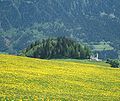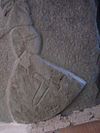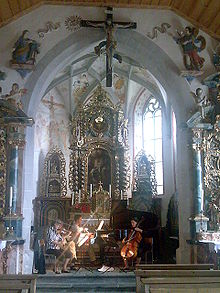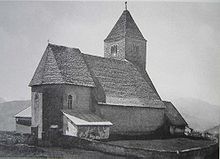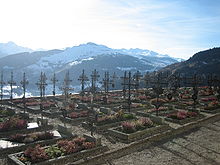Remigius Church (Falera)
The old church of St. Remigius (Baselgia veglia) is the landmark of the village of Falera in the canton of Graubünden in Switzerland. It is consecrated to St. Remigius and included in Falera's coat of arms. Its function as a Catholic parish church was taken over in 1904 by the newly built Herz-Jesu-Kirche .
location
The church is located away from the village at the foot of a wooded hill, the Mutta , near an important place of worship and astronomy from pre-Roman times. The building is surrounded by a ship-shaped cemetery wall. The church and wall are thus a symbol of Noah's ark and are intended to remind people to look for a safe shore.
In order to give the cemetery wall the shape of a ship, a lot of earth had to be piled up so that the tower and church could be built on it. The massive tower has compressed the loosely heaped earth in the southwest and consequently overhangs 50 cm on this side. The special architectural proportions are striking: the length of the church (without the anteroom, which was added later) corresponds exactly to the height of the church tower. This 'square' means that the proportions are perceived as particularly harmonious.
The exterior
tower
The Romanesque, brick and unplastered church tower with its 1.80 m thick walls dates from the 13th century. It is covered with a tent roof made of stone slabs. The sound windows , three at the top and two at the bottom, are provided with columns, capitals and arches. The pillars and arches in the western sound window were removed in 1771, presumably so that a new bell could be raised. During the restoration of the church from 1977 to 1982, the window was returned to its original condition. A late Gothic grave slab with the coat of arms of the von Rink family (14th century) was installed as a lintel plate above the entrance to the tower.
Four bells hang in the tower. The smallest was cast in 1900 by the Theus brothers in Felsberg . It is said to have originally served as a school bell. It is not rung because it does not sound like the others.
The big bell dates from 1771 and is dedicated to Saint Jodokus . It used to be rung in stormy weather. The middle bell, dedicated to Our Lady, dates from 1765. The third was cast around 1300. It has a diameter of 71 cm and bears a high Gothic inscription: a dedication to Saints Remigius and Germanus and to the four evangelists . It is one of the oldest bells that are still rung in Graubünden.
Only part of the clockwork of the old tower clock is left. The clock was delivered in 1853 by clockmaker J. Hupelchofer from Maienfeld and cost 340 francs - the equivalent of four to five cattle. When the tower of the new parish church, consecrated in 1905, received a clock, the clock was no longer maintained by St. Remigius, but ran until around 1920. The white dial on the west side was not removed until 1978.
Vestibule and ship
The vestibule with the ossuary on the north side was added in 1770, as the year in a beam attests. The inner door dates from 1689. The outer portal from 1770 had to be replaced by a new one in 1955; it was made by the local carpenter Andreia Casutt. In 1982 a new portal was made that corresponded to the original from 1770. Casutts portal has been used for the storage chapel since 1888.
The age of the nave cannot be determined with certainty. It is known that the church was built between 1475 and 1491. In the parish archive there are indulgences from the Pope dated October 29 and December 20, 1475. Indulgence was granted to those who helped with the renovation of the Remigius Church.
The late Gothic choir dates from 1491: In that year, the Chur bishop Balthasar Brennwald consecrated three Gothic altars on December 7th.
Certain parts of the church are older, as the door to the northern sacristy has a Romanesque arch. It is conceivable that a church was built at the same time as the tower in the 13th century.
A church in Falera consecrated to St. Remigius is already mentioned in 1045 in a deed of donation from Emperor Heinrich III. mentioned. The document mentions various goods that the emperor owned in Falera, among others, and which he bequeathed to the Schänis monastery . It can be assumed that the aforementioned Carolingian church stood in the same place as the present one; nowhere are there any indications of any other place. One can only guess from what time that church originates.
inner space
The interior consists of a single nave nave and a three-sided Gothic choir . The nave and choir are richly decorated with paintings:
the expressive image of the Last Supper takes up the entire length of the north side. It was painted in 1646 by Georg Wilhelm Gresner from Constance, but was already painted over white in September 1766 by the Obersaxer flat painter Michel Mirer. In 1936, Father Notker Curt 'from the Disentis Monastery became aware of the hidden image and the white top layer was removed by Father Notker and his brother Iso Müller. During the restoration, the faces and sometimes the hands and clothes of three apostles were painted over with a synthetic paint that soon oxidized and darkened considerably.
The first picture in the choir shows the Mount of Olives scene. Below the scene the founder is shown with a coat of arms. This is a priest. The coat of arms is unknown. It could be the coat of arms of the Habsburgs (see Zurich coat of arms from 1340). From 1299 to 1342 the area of Laax ( Grafschaft Laax ) was an imperial fief of the Habsburgs. The picture dates from 1623, as the inscription below the picture shows.
The second picture in the choir shows the crucifixion. In the corner of this picture, the donor is shown in pilgrim dress with a staff and hat. It is a member of the Capol family , as the coat of arms shows.
The third picture in the choir shows the resurrection of Jesus Christ . It shows Christ in the aureole and the soldiers at the grave.
The depiction of the Last Judgment with a Rhaeto-Romanic inscription on the south wall was made around 1800, the painter is not known. It is not considered particularly valuable artistically. The baroque high altar is a richly decorated and gilded wooden structure by the Valaisian Jodok Ritz from 1730. The altarpiece shows St. Remigius as he, as Bishop of Reims, baptizes the converted King Clovis . The painter of the frescoes with angels playing music in the choir is not known. The year 1623 can be seen on a rib of the late Gothic vault. The two stucco side altars were erected around 1660/70. The Gothic wall tabernacle from 1491 was badly damaged when a window was broken out in 1730 and was later reconstructed. The wall paintings next to it show Saints Remigius and Augustine . The pews, originally carved by Florin Cavelti from Sagens, date from 1778, the choir stalls and the gallery parapets with peasant paintings from 1778. The marble holy water basin is decorated with inlay and bears the date 1716.
The original wooden ceiling with carvings and a painting on canvas depicting Jesus and his disciples in a storm on the Sea of Galilee had to be replaced in 1880 and was destroyed in the process. A new wooden ceiling was installed, which was later painted blue. That blue blanket is still under the new blanket that was created in 1980 today. During the renovation of a Maiensäss in 1978, a few boards with scraps of canvas from the old Gothic ceiling came to light. They served as a template for moldings on the south wall near the tower corner of today's ceiling. They were carved by the art carver Duri Caviezel from Chur .
The organ with ten registers was installed in 1896 by the Klingler company from Rorschach . It replaced the first small organ by Pankratius Kayser from 1773. At the same time, the gallery was enlarged.
The church got the floor of natural stone slabs in 1766.
- Church of St. Remigius: interior
Restoration 1975–1982
The plaster was repaired with the same materials (quick lime and milk) as before, the western soundhole was restored to its original state and the tin roof from the 19th century was replaced by the original roof made of larch shingles.
Altars, choir stalls and wall paintings were restored under the direction of Peter Jordi, Wabern near Bern. The layers of paint on the gallery parapet were removed and the organ restored.
Although a grave slab and a male skeleton were discovered when the wooden floor was removed on the north side, no further excavations were made for reasons of cost.

graveyard
The cemetery wall is older than the tower, so it dates from the 13th century at the latest. Until 1960 the dead were buried in family graves. Since this repeatedly led to disputes due to lack of space, the funeral system was reorganized in 1961 and the cemetery was renovated.
On the south side, the cemetery wall was raised by 50 cm. The decision that from now on only iron grave crosses could be used led to a cemetery that forms a harmonious whole with the church and its surroundings.
Special
- In 1889 the well-known Zurich painter Rudolf Koller painted a picture of St. Remigius. It hangs in the chancellery in the Falera parish hall.
- The three churches of St. Remigius, Sogn Sein in Ladir and Sogn Gieri (St. Georg) in Ruschein are all on one line.
literature
- Ignaz Cathomen, Giusep Venzin: Falera St. Remigius. (= Peda art guide. No. 42). Kunstverlag Peda, Passau 1991, ISBN 3-927296-35-X .
- Ignaz Cathomen / Isidor Winzap: Falera - History and Development of a Grisons Mountain Village 2002
Web links
- Official website of the municipality of Falera
- Old Catholic parish church of St. Remigius at www.graubuendenkultur.ch
Individual evidence
Coordinates: 46 ° 47 ′ 57 " N , 9 ° 14 ′ 4" E ; CH1903: 737083 / 184 680




